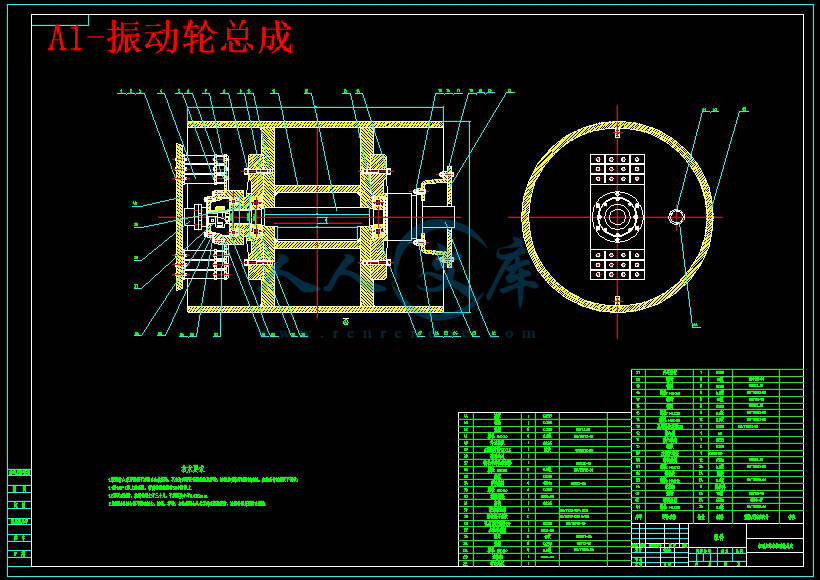【温馨提示】 购买原稿文件请充值后自助下载。
以下预览截图到的都有源文件,图纸是CAD,文档是WORD,下载后即可获得。
预览截图请勿抄袭,原稿文件完整清晰,无水印,可编辑。
有疑问可以咨询QQ:414951605或1304139763
摘要:随着振动压实理论的逐步完善以及新的压实技术和控制技术在压路机中的应用,振动压路机的研究逐渐显出其重要性及必要性。本次毕业设计的主要任务是设计一种常用的YZ07振动压路机,该设计的意义在于研究设计出一种常用的轻型压路机,满足一般压路工况。
由于所选择的YZ07振动压路机为轻型振动压路机,所承受的激振力较小,因此振动轮设计为单振幅、单振频的振动形式,设计较为简单和常用。具有很强的通用性,通过对YZ07振动压路机振动轮中的偏心轴以及所选轴承、激振器的设计计算,确定整个振动轮旋转过程中所产生激振力以及校核部分零件,使之满足YZ07振动压路机的工作需求。
除了振动轮各项参数的设计计算部分,本文还包括了对振动压路机的发展,课题研究意义的分析,以及对本领域目前发展情况的最新进展以及所出现的问题进行研究和讨论。
关键词:振动压路机;振动轮;振动激振器
YZ07 walk-behind vibratory rollers design
Abstract:With the gradual improvement of the theory of vibration compaction and compaction of new technology and control technology in the application roller , vibratory roller research increasingly shows its importance and necessity . The graduation project 's main task is to design a common YZ07 vibratory roller, the significance of this design is to study the design of a common light roller, pressure to meet the general road conditions.
Since the chosen YZ07 vibratory roller for light vibratory roller, which are subject to vibration force is small, so the amplitude of vibration wheel design is a single , single vibration frequency vibration form, design is relatively simple and commonly used. Has a strong versatility , through YZ07 vibratory roller wheel eccentric shaft vibration and selected bearing exciter design calculations to determine the rotation of the entire wheel vibration exciting force generated by the process and check some of the parts to make it meet the work requirements YZ07 vibratory roller .
In addition to the design of the parameters wheel vibration calculation section , the paper also includes a vibratory roller on the development of meaningful analysis of the research , as well as current developments in the field of the latest developments as well as the problems studied and discussed.
KeyWords:Vibratory rollers; vibration wheel; vibration exciter
目 录
第1章 绪 论 1
1.1 国内外压路机产品技术概述与发展趋势 1
1.2 本设计研究内容 2
第2章 总体方案设计 3
2.1 整机方案拟定 3
2.1.1 规格系列 3
2.1.2 行驶方式 3
2.1.3 行走驱动系统 3
2.1.4 车架形式 4
2.1.5 转向方式 4
2.1.6 振动轮总成 4
2.1.7 减振方式 4
2.1.8 整机方案表 4
2.1.9 设计产品型号编制的确定 5
2.2 基本技术参数的拟定 5
2.2.1 名义振幅 5
2.2.2. 工作频率 5
2.2.3 YZ07振动压路机拟达到的主要技术参数 6
第3章 整体参数计算 7
3.1 六个基本参数计算 7
3.1.1 工作重量 7
3.1.2单轮分配质量 7
3.1.3 前轮静线载荷 7
3.2爬坡能力的确定 7
3.3 重心位置 7
3.5 整机稳定性分析 7
3.5.1 稳定性工况分类 8
3.5.2坡道纵向静态稳定性 8
3.5.3 坡道横向静态稳定性 10
3.5.4 上坡稳定性 11
3.5.5 下坡稳定性 13
3.5.6 计算分析讨论 15
3.5.7 关于整机稳定性的分析讨论 15
3.5.8 YZ07压路机稳定性计算分析 15
3.6减振系统设计与计算 16
3.7 振动参数的设计计算 16
3.7.1 振动轴偏心质量和偏心距的计算 16
3.7.2 振幅计算 17
3.7.3 振动频率计算 17
3.7.4 偏心力矩 17
3.7.5 激振力 17
3.7.6 振动轴承的选型及寿命 17
3.7.7 联轴器的选择 18
第4章 YZ07型振动压路机传动系统设计 19
4.1 传动形式的确定 19
4.2 液压行走系统设计 20
4.2.1 液压行走系统方案 20
4.2.2行走系统功率计算 20
4.2.3 液压行走系统元件的选型 21
4.2.4 行走系统的功率校核 22
4.3 液压振动系统设计 24
4.3.1 液压振动系统方案确定 24
4.3.2 振动液压系统所属功率计算 24
4.3.4振动系统功率分析计算及振动性能参数计算 24
4.4 液压转向系统设计 27
4.4.1 液压转向系统方案确定 27
4.4.2油缸参数确定 27
4.4.3转向泵参数确定 28
4.4.4全液压转向器的选取 28
4.4.5 转向操纵功率计算 29
4.5整机功率及发动机选型 29
4.5.1 整机功率计算 29
4.5.2 发动机选型 30
第5章 总 结 31
5.1 本设计的特点 31
5.2 本设计的不足及努力方向 31
总结 33
参考文献 34
谢辞 35
第1章 绪 论
1.1 国内外压路机产品技术概述与发展趋势
20世纪30年代,世界上最早的振动压路机出现在的德国。此后随着振动压实理论研究的深入,避振材料和振动轴承制造技术的不断完善,振动压路机在60年代占领了世界压实机械市场,其品种、规格也呈现多元化发展。随着社会需求对压路机动力性能、运动精度及自动化程度的要求,液压传动技术于60年代应用于压路机,70年代国外的大多数振动压路机已经实现液压传动。随后,电液控制技术在振动压路机上的应用,更使得压路机实现了行走、振动、转向和制动等系统的全液压传动。到20世纪末期,电子技术和计算机技术给压实机械进行了一场控制革命,德国宝马格(Bomag)公司首创了振动调幅压实系统并迅速推向世界市场。目前,国际上全液压传动压路机技术中,液压传动、全轮驱动、铰接转向等技术已经较为成熟,自动控制技术还处于起步阶段,其中振动参数的自动控制已经有了突破性进展,但技术还有待进一步完善[1] [2]。











 川公网安备: 51019002004831号
川公网安备: 51019002004831号